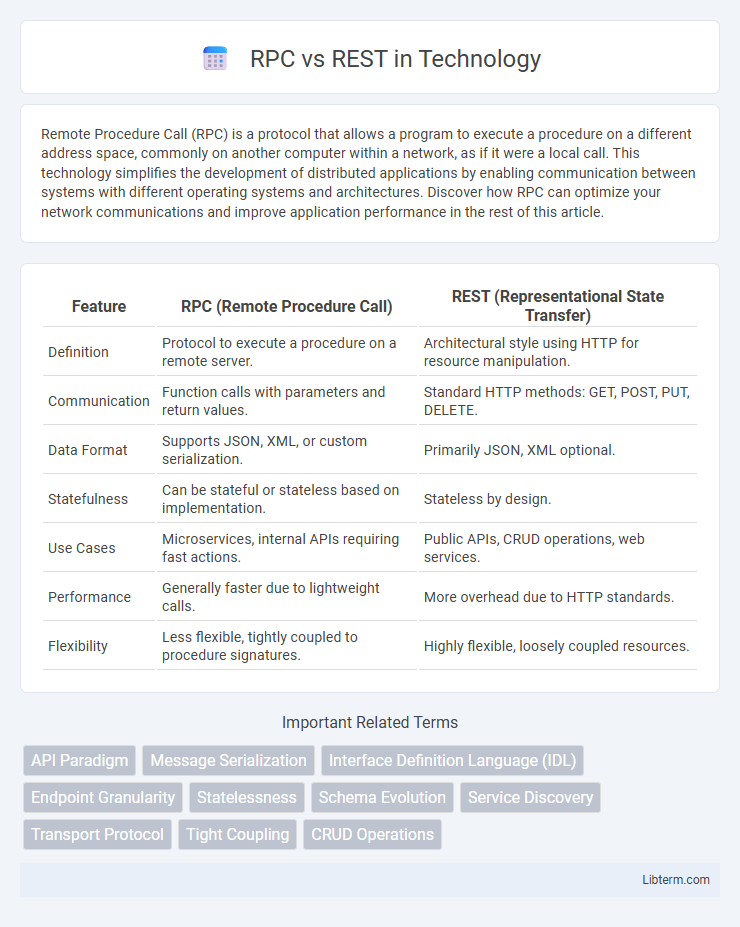Remote Procedure Call (RPC) is a protocol that allows a program to execute a procedure on a different address space, commonly on another computer within a network, as if it were a local call. This technology simplifies the development of distributed applications by enabling communication between systems with different operating systems and architectures. Discover how RPC can optimize your network communications and improve application performance in the rest of this article.
Table of Comparison
| Feature | RPC (Remote Procedure Call) | REST (Representational State Transfer) |
|---|---|---|
| Definition | Protocol to execute a procedure on a remote server. | Architectural style using HTTP for resource manipulation. |
| Communication | Function calls with parameters and return values. | Standard HTTP methods: GET, POST, PUT, DELETE. |
| Data Format | Supports JSON, XML, or custom serialization. | Primarily JSON, XML optional. |
| Statefulness | Can be stateful or stateless based on implementation. | Stateless by design. |
| Use Cases | Microservices, internal APIs requiring fast actions. | Public APIs, CRUD operations, web services. |
| Performance | Generally faster due to lightweight calls. | More overhead due to HTTP standards. |
| Flexibility | Less flexible, tightly coupled to procedure signatures. | Highly flexible, loosely coupled resources. |
Overview of RPC and REST
RPC (Remote Procedure Call) enables direct execution of procedures on a remote server by invoking methods as if they were local, facilitating tightly-coupled interactions with high efficiency. REST (Representational State Transfer) is an architectural style that uses standard HTTP methods to manipulate resources identified by URIs, promoting stateless communication and scalability. RPC prioritizes action-oriented operations, while REST emphasizes resource-based interactions, making each suitable for different application needs.
Key Differences Between RPC and REST
RPC (Remote Procedure Call) focuses on executing a specific function or procedure on a remote server with a tight coupling between client and server, often using protocols like JSON-RPC or XML-RPC. REST (Representational State Transfer) emphasizes resource-based interactions using standard HTTP methods (GET, POST, PUT, DELETE), promoting stateless communication and loose coupling. Key differences include RPC's procedure-centric approach versus REST's resource-centric design, differences in statelessness, and standardized versus custom protocol usage.
Architecture and Design Principles
RPC (Remote Procedure Call) architecture facilitates direct function invocations between client and server, emphasizing procedural abstraction and tight coupling, which enables efficient communication in distributed systems. REST (Representational State Transfer) follows a stateless, resource-oriented architectural style utilizing standard HTTP methods, promoting scalability, loose coupling, and uniform interfaces based on resource representation. Design principles for RPC prioritize method invocation semantics with predefined interfaces, while REST emphasizes resource layering, cacheability, and stateless interactions to enhance web service interoperability and performance.
Communication Protocols Used
RPC primarily uses protocols like HTTP, TCP, or UDP for communication, enabling direct execution of procedures on a remote server. REST relies on standard HTTP methods such as GET, POST, PUT, and DELETE to perform stateless operations on resources identified by URIs. Both protocols facilitate client-server interactions but differ in their approach to message formats and abstraction levels.
Data Formats and Serialization
RPC commonly uses compact binary serialization formats like Protocol Buffers or MessagePack, which optimize message size and transmission speed, ideal for high-performance applications. REST typically relies on text-based formats such as JSON or XML, prioritizing human readability and ease of integration with web technologies. The choice between RPC and REST serialization directly affects payload size, parsing efficiency, and cross-platform compatibility in distributed systems.
Performance and Efficiency Comparison
RPC protocols generally offer better performance and efficiency than REST by enabling direct method calls with minimal overhead, which reduces latency and bandwidth usage. REST relies on standard HTTP methods and stateless communication, introducing additional parsing and serialization that can slow down response times. For high-throughput, low-latency applications, RPC's binary protocols like gRPC outperform REST's text-based JSON, resulting in faster data transmission and improved resource utilization.
Scalability and Flexibility
RPC protocols offer high scalability by enabling direct, lightweight communication between clients and servers, reducing overhead and improving performance in distributed systems. REST APIs provide greater flexibility through stateless operations and standardized use of HTTP methods, allowing seamless integration with various clients and microservices. While RPC excels in tightly coupled environments with high throughput demands, REST supports scalable, loosely coupled architectures adaptable to evolving business needs.
Security Considerations
RPC and REST differ significantly in security considerations due to their architectural styles; REST leverages standard HTTP methods and stateless interactions, making it easier to implement security protocols like OAuth 2.0 and TLS encryption. RPC often requires additional effort to secure the endpoints because it can use multiple transports and custom protocols, which may expose vulnerabilities if not properly configured. Implementing strict input validation, authentication mechanisms, and encryption is crucial in RPC to prevent issues such as injection attacks and unauthorized access, while REST benefits from widespread support in security frameworks and best practices.
Use Cases and Real-world Applications
RPC is ideal for microservices communication where low-latency and high-performance are critical, such as in real-time gaming and financial trading platforms. REST excels in web and mobile applications requiring stateless interactions, scalability, and easy integration, like social media platforms and e-commerce APIs. Enterprises often adopt RPC for internal service calls in distributed systems, while REST is preferred for public-facing APIs due to its simplicity and widespread support.
Choosing the Right Approach: RPC or REST?
Choosing between RPC and REST depends on the specific needs of your application, such as complexity, scalability, and communication style. RPC (Remote Procedure Call) offers direct and efficient method invocation ideal for tightly coupled systems requiring low-latency interactions, whereas REST (Representational State Transfer) provides a stateless, resource-oriented architecture well-suited for web services prioritizing scalability and ease of integration. Consider factors like data format compatibility, performance requirements, and developer familiarity to determine the optimal approach for your API design.
RPC Infographic

 libterm.com
libterm.com